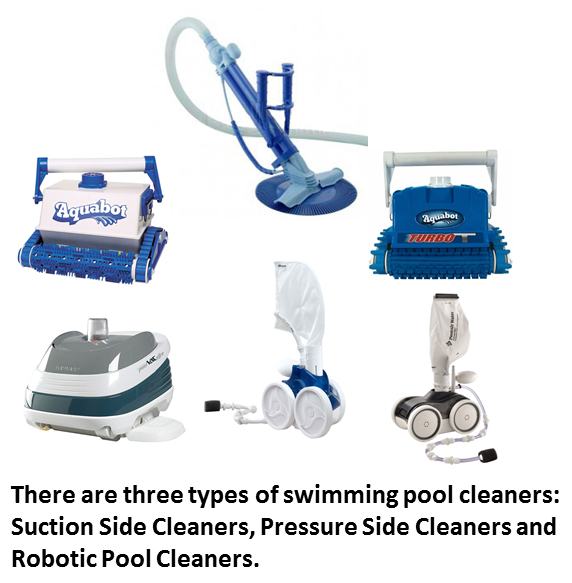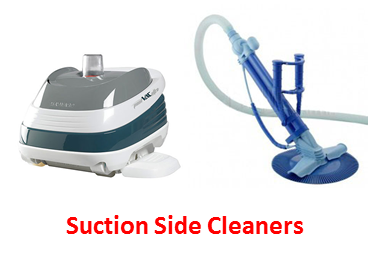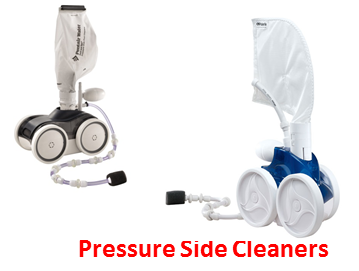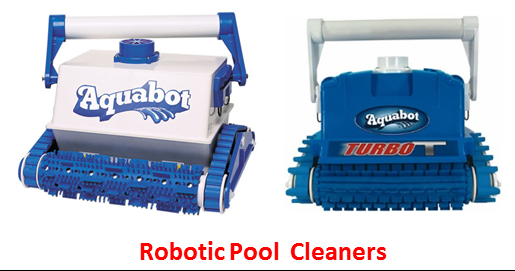
Automatic Pool Cleaners
The automatic pool cleaner is a device that leap right into the hearts of pool owners and service technicians alike. In a genesis similar to that of human air flight, engineers and inventors have produced gadgets of fancy in the hopes of finding one that will fly. Several have achieved wide-spread use and acceptance by consumers and the service industry. These are described below and are broken into three categories; Suction Side Cleaners, Pressure Side Cleaners and Robotic Pool Cleaners.

Suction Side Cleaners: All Pool Types
These are cleaners that attach to the suction side of your plumbing. The suction side refers to the pipes and fittings that bring water out of the pool to be filtered; that water which is being “sucked” out of the pool by the filter pump. Usually this is the pool skimmer, and you attach the hose from the cleaner into the hole in the skimmer beneath the basket, or use a skimvac attachment and it vacuums into your skimmer basket. Some pools have a dedicated suction cleaner line, a nice luxury to have. In these cases, you attach the cleaner directly to a wall fitting, usually located in the middle of the long side of the pool.
Suction pool cleaners include the Hayward PoolVac Ultra, Navigator, Aquabug, Kreepy Krauly, E-Z Vac, Baracuda Ranger, G3, Polaris 150, and ATV. Please visit our Swimming pool cleaners page for a complete list of suction side cleaners. These are divided in roughly two types, the flat, round disk or pulse type cleaner, and the hydro drive train powered types like the Polaris ATV and the Hayward Navigator style cleaners. With the hose attached and the filter pump running, suction is created on the underside of the cleaner. The cleaner moves randomly, or automatically around the pool with motion created by a device that gives a stop/ start pulsing of water. As the unit travels, debris is sucked up through the neck and then the hose, past the suction port, through the pipe, and stops at the filter pump strainer basket, while smaller debris passes through to the filter. Adjustments on the hose, the unit itself, and flow volume will create different cleaning patterns, so as to maximize pool coverage. The more flow is generally better for speed and vacuum ability, however too much suction can cause the cleaner to move too fast or possibly get stuck on uneven areas of the pool floor.
Suction Cleaner moving slowly?
Start by checking the pump basket for debris and making sure the filter is clean and water is flowing properly. Holding the cleaner head underwater, so as to not suck air into the pump, check out the throat of the cleaner for any obstructions. Check both ends of the hose for obstructions or clogging. Check hose connections and each hose section for splits, obstructions or holes. If your pool has lots of leaves (trees), you’ll want to have an in-line leaf trap to use with your suction cleaner. Very heavy leaf volume may overwhelm a suction cleaner. In this case, use a leaf net first to scoop large debris [slowly] off of the pool bottom.
Suction cleaners are sold for both inground and aboveground pools. What this really means is that they are sized to the pool pump. If you have an aboveground pump, then your pump will not be powerful enough to move the inground model around the pool. Similarly, if you have a larger inground pool pump, it may overpower some aboveground pool cleaners. Inground plaster pools definitely need to use the inground suction cleaner models which are built to handle the rougher plaster surface.
Cleaner not cleaning the entire pool?
Some of the top reasons for this include: The hoses could be too short. Another real common cause is the cleaner could be following the flow pattern of the water in the pool, in other words, strong flow from wall return jets will push the cleaner into a pattern. To fix this; adjust the return port wall fittings, or add wall fittings to the return ports. It helps to point the fittings down or at a downward angle. If you pool doesn’t have wall fittings at the return ports there are alternative wall fittings made by the manufactures to divert the flow.
Most suction cleaners are the cheapest cleaners to own in terms of needed replacement parts. Many have only 1 moving part, and need very few replacement parts. Always rotate the wearable parts on the cleaners and replace those wearable parts when needed. Most suction cleaners will need less than $50 per year to stay operating at peak performance.
If you have only one skimmer, most skimming action is lost while your cleaner is hooked up. Secondly, unless the cleaner has an in-line strainer basket somewhere on its hose, the filter pump basket can get clogged up rather quickly. That, or if the strainer basket becomes full, reduces filtration and puts more front pressure on the system by restricting the flow into the filter. My opinion is that having a suction side cleaner would be much better than having none at all, but less than what is possible. On the bright side, suction side cleaners are available for half the cost of pressure side cleaners, and have low maintenance costs.

Pressure Cleaners: In-Ground Pools
Pressure side cleaners are those that attach to the pressure side (return) of your pool’s circulation system. Also called booster pump type cleaners, the water that is pumped or “pushed” back to the pool propels these units which have their own hydraulic power plant inside. Being on the pressure side [and not the suction-side], these units have distinct advantages. They are helpful in distributing clean filtered water around the pool and having their own debris bag means that they don’t compromise the filter system by bringing dirt and debris into the pump basket and pool filter. Even with the bag full, a pressure cleaner still operates, stirring debris up; it just won’t suck up much more debris until the bag is emptied.
These cleaners attach to one of the existing return ports and are powered by the pool pump (Polaris 360, Letro Legend II, Jandy Ray-Vac, etc.), or to a dedicated cleaner line with an additional Booster Pump (Polaris 180, 280, 380 and Letro Legend). For a complete list of swimming pool pressure cleaners, please visit our cleaners page.
The water that flows into the unit splits into three directions; the sweeper tail, the thrust jet and the venturi.The sweeper tail is a little “stirrer-upper” as I call it, which helps to get fine debris off the walls and floor and into the suspension where it can then head towards the filter. The thrust jet are the jets on the back of the cleaner that help propel and direct the unit. Similar to the exhaust in a car, the thrust jet is the exit point of water that has gone through the “Water Management System, which is a series of ports and gears that drive the unit around the pool in a random pattern. The venturi is the port on the bottom where leaves are sucked up into a bag (that you empty when full) as the unit rolls around the pool. An in-line back-up valve in the feed hose reverses the flow every few minutes to change the cleaning pattern and remove the cleaner from possible obstacles.
The Polaris 180, 280, 380, 480 and 3900 Sport and the Letro Legend models require a booster pump to power the unit. These cleaners need about 30 PSI to operate their hydrogears, or water management system, effectively. Most filter systems don’t run that high of pressure to power these cleaners properly. When installing a pressure side pool cleaner, the return pipe is cut (after the filter), and a “Tee” fitting installed. Feed water is thusly directed to the booster pump which then pumps water through a dedicated line, usually installed midway down the pool wall. This line can be run under the deck and through the pool wall, or over the deck for a cheaper installation.
Without the booster pump, these units would crawl along slowly, picking up very little debris. Polaris 360 models operate at only 15 – 17 PSI, and are not intended for use with a booster pump. Letro followed suit and introduced the LEGEND II. These two cleaners I call “low-pressure side cleaners.” This has given these manufacturers a whole new “market share” by reducing the cost of installing one of their cleaners. The 360 & Letro operate in a very similar fashion to the booster pump cleaners and connects to one of the existing return ports. A test is made at that return port to determine if the circulation system can deliver the proper amount of pressure to operate the unit.
The 360 will not work well for pools with floor returns or “slit” returns of crushed copper pipe, or pools with small, slow circulation systems. The 360 and Legend II can be as effective in cleaning the pool as the booster pump driven models, although very dependent on the effective operation of your pump and filter system. The main advantage to the booster pump models is that they are usually run with a time-clock, and can thus turn themselves on and off automatically, saving energy and wear and tear from operating too long.
Pressure-Side Cleaner moving slowly?
Pressure side cleaners operate independently from the pool filter system, and are not usually affected by a dirty filter or full pump basket, for instance. The booster pump delivers a fairly consistent flow rate to a pressure side pool cleaner. If your unit is operating slowly, check the inline strainer, usually at the wall fitting, to make sure it is clean. This small steel strainer should be checked regularly. The wall fitting also has an adjustable pressure bleed-off valve, to allow excess water pressure to escape. Open this valve too much and your cleaner may become sluggish.
Inspect the hose from the wall to the unit, making sure there are no splits or holes allowing pressure [water] to escape. A small amount of leakage at the swivels is normal. When you get to the unit itself, lift it slightly out of the water to inspect the water flowing out the back through the thrust jets. A solid steady stream should spray out of the back, shooting 10-20 feet. Likewise, with the debris bag removed, the stream spraying from the venturi, out the top of the unit, should reach heights of nearly 20 feet. If either of these is lacking, there may be an internal loss of water, in the water management system.
If the water pressure is fine, you will want to inspect the wheels and the gears or belts that drive them. Sticks or sand can jam up the wheels, and wheels need to be adjusted to engage the gears or belts properly. Too loose or too tight and your cleaner just won’t get traction. Drive belts or drive shafts will need to be replaced every so often, as they wear over time. Tires can become rounded, especially on rough plaster pool surfaces. This will affect speed somewhat and climbing ability.
Pressure-Side Cleaner not cleaning the entire pool?
Adjustments to the thrust jet can create different cleaning patterns around the pool. Default setting is 11:00, but you can try 1:00 o’clock, to have the cleaner track in the opposite direction. The length of the hose is important, does it have enough hose to reach the far corners? Too much hose can also be a problem, creating a tangled feed hose, or disrupting cleaning patterns. Steps and loveseats won’t get much attention from your pressure side pool cleaner. Just hit these with a brush or net regularly to keep them clean.
Pressure-Side Cleaner becoming stuck in one area?
If your pool cleaner gets stuck behind the ladder, you can use one of the many available ladder guards to prevent the cleaner from getting back there. Likewise, if stuck on the main drain of the pool, main drain covers exist that smooth the transition from floor to drain. Pressure-side pool cleaners use an inline back-up valve, or a hydrotimer device, in the feed hose. This hydro-timer allows water to escape the device every 3 minutes or so. Water stops flowing briefly to the cleaner, and this escaping water fromt he back-up valve will lift the cleaner off the floor for just 15 seconds or so. As the hydro-timer once again allows water to pass through the back-up valve to the cleaner, the re-positioned cleaner can now operate in a new direction and orientation. These back-up valves and hydro-timers can malfunction or become clogged with small bits of sand, allowing the unit to become stuck.
Pressure-Side Cleaner hose tangling?
You may have too much hose, follow manufacturer’s recommendations for sizing the hose to fit your pool [important!]. The unit may be overpowered, allowing it to loop around wildly, tangling itself. The hose swivels may not all be functional, check each one to make sure they are “swiveling”.

Robot Cleaners: All Pool Types
Self-contained, low voltage electric cleaners which are put into the pool when there is a need for cleaning. Common brand names include Aquabot, Dolphin, and AquaVac. Please visit our swimming pool cleaners page for a complete list of robot cleaners. A transformer is plugged into a wall outlet and a 50 ft long {cord length varies by cleaners} cord from the unit plugs into the transformer. The transformer takes 110volts from your outlet and “transforms” it, or “steps it down” to the much-safer-around-water 24 volts. This low voltage power operates the cleaner. This power operates two motors; a pump motor which draws debris into the unit’s filter, and a drive motor which moves the unit around the pool.
The advantage of owning a robot pool cleaner includes their self contained filter, which is easily cleaned. They also do quite well with their pool coverage and speed. Some units are computer chip controlled and some even have remote controls so you can steer the unit from a lounge chair! Being that they are the only cleaners not attached in any way to the pool’s circulation system, they produce no resistance or back pressure on the filtering. In fact, the process of pumping your pool water through the internal filters of the cleaner can reduce the work required of your pool filter. Robot pool cleaners are also mini pool filters, and some models filter down to 2 microns!
On the downside, the cost of a robotic pool cleaner can be more than suction or pressure side cleaners. They are somewhat heavy to handle, and some repairs can be costly. Not the best choice for heavy debris, with large sticks, leaves or acorns.
A new type of Robotic pool cleaners, known as Jet pool cleaners, are still very much robotic, but with high flow and a simpler design with fewer parts. Also available at a lower price point than original robotic pool cleaner designs, Jet Robotic pool cleaners have gained a strong foothold in the marketplace.
Aquabot does not move?
Is the indicator light glowing on the transformer? If not, be sure that transformer is turned on and that the 3 volt fuse is not blown (the indicator light can be glowing even though the fuse is blown). Check the electrical outlet with another electrical appliance to be sure that power is available. If the power is available, and the fuse is good try wiggling the power cord plug from the unit to the transformer. Older units may begin to short out at the plug; a new plastic female plug is available.
Inspect the unit itself while it’s partially underwater. Is the pump motor receiving power? Is there water gushing out of the top of the unit? This would indicate that power is reaching the unit. Is the pulley on the drive belt side turning? If the pulley is not moving this could indicate a shorted drive motor or a corroded drive T, which would also require motor replacement.
Are the drive belts tight and in good repair? Drive belts become stretched and weaken over time. If your belts are “skipping” and are not locked into the grooves of either the drive pulley or the wheel tubes they may need to be replaced. Check that the wheel tubes are in proper position with bushings in place on either end. If the tubes are not straight the drive belts will not be tight. Drive Tracks also can be checked. These are the treads that contact the pool surface. Over time they will wear down their raised pads. If they are loose, check that all of the wheel tube end bushings are in place.
Do not pull the unit towards the side of the pool, or lift the unit out of the pool by the power cord. Try to reach into the pool and lift the unit only by the handle.
Aquabot does not pump?
If the unit moves, but does not pick up any debris, lift the unit up near the surface of the water. Does water gush out of the top? If not, the pump motor may be shorted. Unplug the unit and pull it out of the water. Remove the vent cap on top of the unit and check that the impeller does not have string wound around the base. Turn the impeller by hand to check spin. Plug in the unit and check spin. If there is no spin the pump is probably shorted. Another indication that the pump motor is not working properly is if the unit won’t climb the walls very far before falling off. The pump motor provides the suction it needs for climbing.
AquaVac Tigersharks have a one piece motor assembly that serves the dual purpose of a drive motor for propelling the unit and a pump motor to do the vacuuming and provide wall suction during climbing. All motors for robotic units are not meant to be serviceable, and they are replaced whole.
Aquabot does not vacuum well?
Some debris can be too large for robotic cleaners, which tend to perform better with smaller debris. If you have large leafed trees nearby, after storms you may need to use a leaf rake or leaf master to get the larger debris, before lettting your robotic pool cleaner do the fine clean-up of the pool.
As a robot pool cleaner fills with dirt, it’s vacuum power or suction will decrease, and this is usually a sign that you need to clean out the internal filter bag or cartridges. Either one can be quick rinsed in a skimmer, or hosed for a more thorough cleaning.
If you filter is clean and your Aquabot still passes over dirt, make sure that the bottom assembly is tight, and that you are not missing any intake valve flaps that most models use. These flaps are important also to prevent debris from falling out when the unit shuts off or you lift the cleaner out of the pool.
Swimming Pool Cleaners Suppliers and Models:
Hayward DV5000
Hayward Navigator Pro
Hayward Pool Vac Classic
Hayward Pool Vac XL
Hayward SharkVAC
Hayward TigerShark
Pentair Kreepy Krauly Classic
Pentair Kreepy Krauly Great White
Pentair Kreepy Krauly Kruiser
Pentair Kreepy Krauly Legend
Pentair Kreepy Krauly Legend II
Pentair Kreepy Krauly Platinum
Pentair Kreepy Krauly Prowler 710
Pentair Kreepy Krauly Prowler 720
Pentair Kreepy Krauly Prowler 730
Pentair Kreepy Krauly SandShark
Zodiac Baracuda G2
Zodiac Baracuda G3
Zodiac Baracuda Ranger
Zodiac Baracuda Wahoo
Zodiac Baracuda X7 Quattro
Zodiac MX 8
Zodiac Polaris 3900 Sport
Zodiac Polaris 9300 Sport
Zodiac Polaris 9300xi Sport
Zodiac Polaris Turbo Turtle
Zodiac Polaris Vac-Sweep 165
Zodiac Polaris Vac-Sweep 180
Zodiac Polaris Vac-Sweep 280
Zodiac Polaris Vac-Sweep 360
Zodiac Polaris Vac-Sweep 380
Zodiac Polaris Vac-Sweep 480
Zodiac Polaris Vac-Sweep 65
Zodiac T5 Duo
